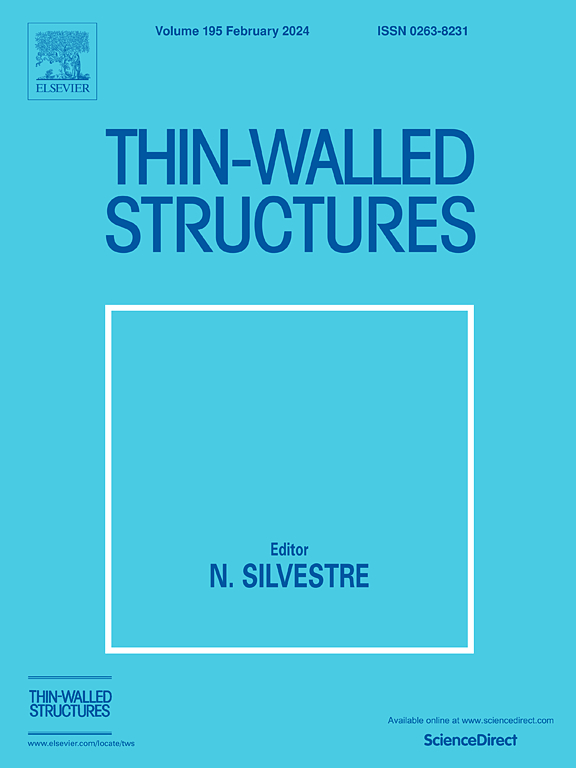Quasi-static crushing response of a novel triaxial isotropy mechanical metamaterial with dual-platform property
IF 5.7
1区 工程技术
Q1 ENGINEERING, CIVIL
引用次数: 0
Abstract
A novel triaxial isotropy origami metamaterial with dual-platform is proposed by combining the tachi tubes and the honeycomb structures. Crushing responses of the hexahedral metamaterial under quasi-static compression load are investigated through experimental tests and numerical simulations. Experimental and numerical results reveal that the hexahedral metamaterial sample shows three deformation modes. Meanwhile, the numerical predictions of deformation modes and locations agree very well with the experimental results. Moreover, the effect of aspect ratio, thickness-to-span ratio, angle on the deformation mode, peak stress, plateau stress of different stages, and specific energy absorption (SEAM, SEAV) is investigated. Finally, the proposed metamaterial is compared with traditional honeycomb. The numerical results demonstrate that the SEAM of the hexahedral metamaterial is 90.6 % of the traditional honeycomb in the Z-direction. However, during X/Y-direction compression, the energy absorption capacity of the hexahedral metamaterial is 13.0 and 12.2 times that of the traditional honeycomb, respectively.
具有双平台特性的新型三轴各向同性力学超材料的准静态挤压响应
通过结合太极管和蜂巢结构,提出了一种新型三轴各向同性双平台折纸超材料。通过实验测试和数值模拟研究了六面体超材料在准静态压缩载荷下的挤压响应。实验和数值结果表明,六面体超材料样品呈现出三种变形模式。同时,变形模式和位置的数值预测与实验结果非常吻合。此外,还研究了长宽比、厚跨比、角度对变形模式、峰值应力、不同阶段的高原应力以及比能量吸收(SEAM、SEAV)的影响。最后,将所提出的超材料与传统蜂窝材料进行了比较。数值结果表明,在 Z 方向上,六面体超材料的 SEAM 是传统蜂窝的 90.6%。然而,在 X/Y 方向压缩时,六面体超材料的能量吸收能力分别是传统蜂窝的 13.0 倍和 12.2 倍。
本文章由计算机程序翻译,如有差异,请以英文原文为准。
求助全文
约1分钟内获得全文
求助全文
来源期刊

Thin-Walled Structures
工程技术-工程:土木
CiteScore
9.60
自引率
20.30%
发文量
801
审稿时长
66 days
期刊介绍:
Thin-walled structures comprises an important and growing proportion of engineering construction with areas of application becoming increasingly diverse, ranging from aircraft, bridges, ships and oil rigs to storage vessels, industrial buildings and warehouses.
Many factors, including cost and weight economy, new materials and processes and the growth of powerful methods of analysis have contributed to this growth, and led to the need for a journal which concentrates specifically on structures in which problems arise due to the thinness of the walls. This field includes cold– formed sections, plate and shell structures, reinforced plastics structures and aluminium structures, and is of importance in many branches of engineering.
The primary criterion for consideration of papers in Thin–Walled Structures is that they must be concerned with thin–walled structures or the basic problems inherent in thin–walled structures. Provided this criterion is satisfied no restriction is placed on the type of construction, material or field of application. Papers on theory, experiment, design, etc., are published and it is expected that many papers will contain aspects of all three.
 求助内容:
求助内容: 应助结果提醒方式:
应助结果提醒方式:


